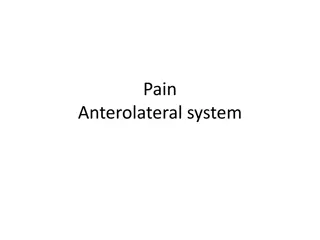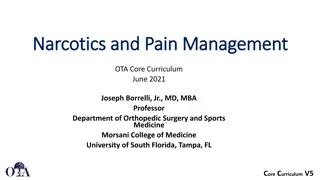Collaborative Approach to Pain Disorders: Nutrition, Lifestyle, and Provider Roles
Clients experiencing pain disorders can benefit from a collaborative care approach involving nutrition, lifestyle modifications, and understanding the provider's role in treatment. Addressing inflammation, gastrointestinal issues, weight management, and depression through personalized dietary plans, exercise, and monitoring outcomes can help improve symptoms and overall well-being.
Download Presentation

Please find below an Image/Link to download the presentation.
The content on the website is provided AS IS for your information and personal use only. It may not be sold, licensed, or shared on other websites without obtaining consent from the author.If you encounter any issues during the download, it is possible that the publisher has removed the file from their server.
You are allowed to download the files provided on this website for personal or commercial use, subject to the condition that they are used lawfully. All files are the property of their respective owners.
The content on the website is provided AS IS for your information and personal use only. It may not be sold, licensed, or shared on other websites without obtaining consent from the author.
E N D
Presentation Transcript
Treatment of Clients Experiencing Pain Disorders A Collaborative Approach to Care June 2, 2018 * Tex-CHIP Training Series
Role of Nutrition & Lifestyle in Prevention/Management of Pain Disorders
Understanding Provider Role in Treating Pain Disorders Each food choice either increases or decreases inflammation Assess diet pattern in patient Individualization Maintain or lose weight Restriction and/or Avoidances High Inflammatory Foods: Dairy Grains/Gluten Soy Refined Carbohydrates Saturated Fats Excess consumption omega-6s Monosodium glutamate (MSG)
Considerations when Interacting with Clients Depression Multiple autoimmune diseases causing chronic inflammation and pain: lupus rheumatoid arthritis celiac disease psoriasis irritable bowl disease Weight gain (depression, coping mechanisms) Alcohol consumption Medication interactions B12 deficiency and metformin methotrexate reduces absorption of folic acid , can altered taste, cause nausea, vomiting, diarrhea
Our Treatment Plan Healthcare Domain: Nutrition Provider: Dietitian Goals: Interventions: Objective: Provide alleviation of presenting trauma symptoms as indicated by client report of: (a) Inflammation internally or externally (b) Gastrointestinal irritation (c) Overweight/Obesity (d) Depression a) Identify food group(s) causing inflammation to patient a) Eliminate entire food group (i.e. dairy, gluten) focusing on one at a time for 3 weeks. Then reintroduce food group for 1-2 weeks. b) Decrease consumption processed foods, increase consumption of vegetables and fruit (individualized goal for amount) b) Follow vegetarian, vegan or Mediterranean meal pattern. c) Engage in physical activity 30 minutes each day. c) Reduce weight 7-10% if overweight or obese (BMI <30).
Measuring Outcomes/ Success Identifying food group(s) that worsen symptoms successfully through elimination diet If chronic inflammatory disease, reduction of symptoms from diet Decrease in processed foods consumed Increase in vegetables and fruits consumed Weight loss (7-10%) Consistent exercise 30 minutes every day
Communication from Counselors Report patient coping techniques (i.e. marijuana use, alcohol, sweets) Diet quality Living arrangements Mobility to shop/cook food Food security status/socio-economic























